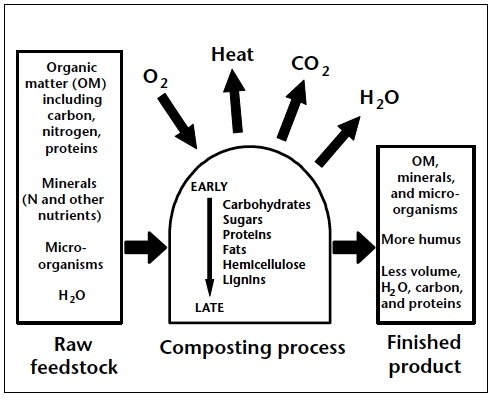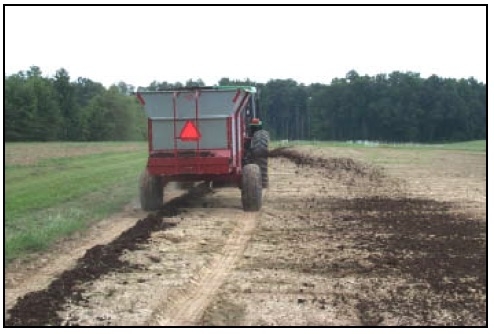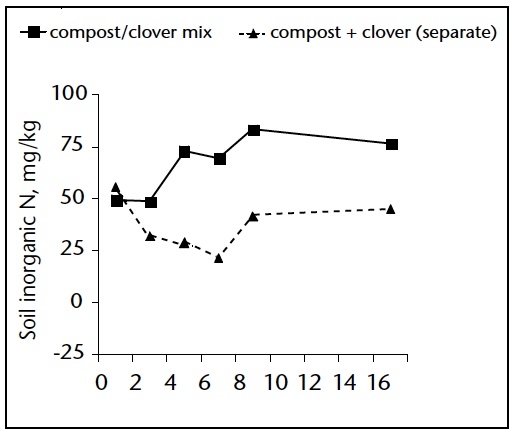Introduction
Small farmers across North Carolina and the rest of the Southeast rely heavily on compost as a valuable part of their production systems—from small-scale organic community-supported agriculture (CSA) farms and market gardens supplying the state’s city-dwellers with fresh, sustainably grown produce to larger operations producing tomatoes or strawberries for processing or wholesale. The region’s farmers, like their counterparts worldwide, use applications of decomposed organic waste to maintain fertility, guarantee yields, and improve the overall quality of their soil. The growth of the organic industry over the last decade, as well as widespread recognition of the need to use practices that regenerate agricultural resources, have inspired farmers to seek out alternatives to conventional methods of soil fertility management. As a result, farmers and researchers alike have tweaked and improved composting on all scales—from small piles for garden use to industrial windrows for municipal and agricultural waste management.
What’s Happening in There?
In a nutshell, the breakdown of organic matter, also called feedstocks, during the composting process depends on several factors working together. These include moisture, microbial populations, oxygen (O2), and a balance of carbon (C) and nitrogen (N). Bacteria that live in the feedstocks consume the easily digestible C in the form of carbohydrates, sugars, and proteins (Figure 1). As they metabolize this food, temperatures increase in the compost pile, and carbon dioxide (CO2) is released. The rising heat attracts thermophilic or heat-loving bacteria that quickly populate and consume the rest of the degradable C. During this time, the pile “settles” and gets smaller. When the microbes run out of easily digestible C, the temperature in the pile drops. This creates favorable conditions for colonization by fungi, which slowly consume much of the remaining forms of C that break down more slowly—lignin and cellulose. The resulting crumbly, earthy humus is considerably more stable than manure, meaning that its nutrients are less likely to leach or volatilize into the atmosphere. As compost matures, N is transformed from its organic form to its mineral forms of ammonium and then nitrate, the preferred form for plant uptake.
Unlike traditional manure or farmyard waste stockpiling, composting is the active management of organic waste to optimize conditions in the pile, leading to rapid decomposition with as little loss of nutrients as possible. By ensuring that microorganisms have enough water and oxygen, and a balance of C to N, farmers and nursery-owners can turn organic waste into a valuable soil amendment.
Making Compost
Balance the Carbon-To-Nitrogen (C:N) Ratio
The C:N ratio needs to be somewhere between 20 and 30. Feedstocks high in C, such as yard waste, wood chips, straw, or dry stalks, need to be mixed with materials high in N, such as manure, freshly cut grass, plant residues, or food wastes. If the C:N is too high, the compost pile will not heat up and instead will break down very slowly. If the C:N is too low, then valuable N will be lost as ammonia. For compost to be used on certified organic fields, it must have an initial C:N between 40:1 and 25:1.
Calculating the actual C:N of your feedstock requires chemical analysis of the waste material, available for a small fee from the N.C. Department of Agriculture and Consumer Services (NCDA & CS) Agronomic Division lab. However, you can use the C:N ratios provided in Table 1 to estimate what kind of blend you need.
| Material | Range of C:N ratios |
|---|---|
| Swine manure | 8 to 20 |
| Vegetable waste | 10 to 20 |
| Grass | 12 to 25 |
| Poultry litter | 5 to 20 |
| Cow manure | 20 to 25 |
| Horse manure | 20 to 30 |
| Straw | 40 to 100 |
| Dry leaves | 30 to 80 |
| Corn stalks | 60 to 70 |
| Newspaper | 400 to 800 |
| Woodchips | 100 to 500 |
To calculate the C:N of more than one feedstock, use this simple method:
(C:N Feedstock 1 × % of total mix) + (C:N Feedstock 2× % of total mix) = Total Feedstock C:N
So, to calculate the C:N of a pile with half cow manure and half straw, you calculate:
(20 × 50%) + (40 × 50%)
The C:N of the compost blend is 30.
To speed up the composting process, make sure that high C material, such as yard waste, straw, crop residues, or newspaper, has been shredded or chipped before adding it to your compost pile. By chopping up this material, you increase its surface area—the number of available sites where the composting microbes can to go to work.
Maintain adequate moisture. To maintain optimal composting conditions for the hard-working microbes, make sure that there is adequate moisture—between 40 to 50 percent of its total weight. The easiest way to estimate this is with “the squeeze test.” Grab a handful of compost and give it a squeeze. It has the proper amount of moisture if you can squeeze some water droplets out of the compost, and it stays in a ball when you release your grip. If a lot of water drips out, then it is too wet and needs to dry for a few days. If it is crumbly, dry, and falls apart when you release your grip, then it is too dry and needs water. Many wet feedstocks, such as pig or dairy manure, do not need additional water at the beginning but may need more as moisture evaporates or leaches from the pile.
Aerate for oxygen and heat. If a pile of organic material is left unturned, it will eventually decompose. But it can take more than a year, and valuable nutrients will have slowly leached away. Regular turning of a compost pile aerates it, which provides the oxygen that aerobic bacteria need to do their work. If the pile is not aerated, it can become smelly as anaerobic microorganisms become active, releasing methane and hydrogen sulfide. If your pile smells like rotten eggs, it has become anaerobic and needs to be turned immediately. If the pile is hot but too wet, nitrogen is lost as ammonia. If you smell ammonia when turning your pile, add some more carbonaceous (high C:N) material to help “trap” some of the N (see Table 2).
The temperature of the compost pile should climb above 135 or 140° F in the first three to five days. Once it peaks and begins to drop, you must aerate the pile. Then the temperatures will rise again. This thermophilic period of heating and aerating should last two to three weeks. These high temperatures must be maintained to kill harmful pathogens and weed seeds that may enter with the feedstock.
| Problem | Solution |
|---|---|
| Pile not heating up | Add water if dry; add N if moist. |
| Pile hot only at center | Pile too small: add feedstock, aerate. |
| Pile is decomposing, but is not hot | Add N. |
| Pile smells rotten | Aerate. |
| Pile smells of ammonia | Aerate, add C. |
We recommend that organic farmers consult the National Organic Standards, which strictly define which feedstocks can be composted as well as the pile temperature and frequency of aeration. For example, a windrow (a long compost pile) must maintain a temperature of 131 to 170°F for 15 days and be turned at least five times.
Ensuring Compost Quality
This is perhaps the biggest hurdle to integrating composting into a farming system. Because there are few standards in place, composts of variable qualities are available on the market. Composts are made of various types of feedstocks, so they vary in chemical and physical composition. It is important to know what to look for when locating a com- post for use on your farm. Find out the origin of the feedstocks used in the compost. Many widely used composting materials (such as sheetrock and other construction materials) are not allowed under National Organic Standards, and they may negatively affect your soil.
In general, mature, high-quality compost is dark and crumbly with an earthy smell. There are no large fragments of high C material, such as sticks or manure clods. It is no longer hot because the composting process has been completed. The presence of organic acids in “hot” compost could “burn” your crops. If a chemical analysis is available, the C:N needs to be less than 25, and the nitrate levels need to be higher than ammonium levels. High ammonium levels indicate immature compost and can be toxic to plants. The pH of a stable, mature compost is close to neutral (7.0). The C:N of a mature compost will be about 8:14.
Using Compost
Although composts are sources of important nutrients, a crop may not get all of the nutrients it needs from compost alone. On average, compost contains between 0.5 and 2 percent N. If the compost C:N is less than 15, only a fourth to a half of the N may be released from its organic form over the growing season. A 1-ton-per-acre application rate of compost may provide only 2 ½ to 20 pounds of N per acre in the first year. The rate of nutrient release depends on several factors—the soil type, the C:N, the homogeneity of the compost, and the method of application. Compost that is incorporated will release nutrients faster than compost applied as mulch. A high C:N (greater than 20) or a heterogeneous compost containing fragments of high C material may actually immobilize or “tie up” N, reducing the amount available for use by the crop. Availability of phosporus (P) and potassium (K) is higher, around 80 percent.
Determining an application rate. Look at an analysis of the compost to determine the C:N and nutrient content. If the C:N of your compost is between 10 and 15 and you plan to incorporate it, assume that 25% of the total N will be available. First, calculate the total N of the compost on a wet weight basis:
total N × % dry matter (DM)
For example:
18,785 ppm (total N dry) × 54% DM
= 10,144 ppm (total N wet)
Convert to pounds of N per ton of compost; multiply by 0.002:
10,144 ppm × 0.002 = 20 lb/ton
Multiply by the availability coefficient:
20 lb/ton × 25% = 5 lb/ton
If your soil test recommends 140 lb/ac of N for a corn crop, then divide the recommendation by the available N:
140 / 5 = 28 tons of compost per acre
While it would meet the N requirement of a corn crop, applying 28 tons of compost may not be economical, depending on the size of your field.
In sustainable farming systems, farmers focus on “building” the soil over time with smaller applications of 5 to 10 tons per acre that improve the soil structure and nutrient-holding ability, and provide slow, long-term release of nutrients from their organic form. To meet the nutrient needs of their crops, many organic farmers in North Carolina use N fixing cover crops, such as clover, vetch, or soybeans, or organic amendments, such as soymeal, feather meal, or fish emulsion, to fertilize their crops.
Compost releases nutrients slowly. A one-time application may have a residual effect, releasing nutrients for an additional one to two years. Transport- ing and applying compost can be costly, and it may be more cost-effective to apply every few years rather than annually.
Compost increases humic matter in the soil. Rather than thinking of compost as a fertilizer, think of it as a soil conditioner that can improve the physical, chemical, and microbial properties of your soil. The humic substances in compost, which give it a crumbly texture, act as a sort of glue that binds soil and organic particles together. As a result, small “crumbs” of soil, called aggregates, are more resistant to erosion.
Greater soil aggregation also increases the porosity of the soil, meaning that there is more airspace or pores between soil particles. This leads to better infiltration of water, conserving moisture and reducing the likelihood of erosive surface runoff. Increased porosity can also allow deeper root penetration, leading to stronger, healthier plants. And it also allows for better aeration of the soil, providing oxygen to plant roots and soil microbes.
Compost can increase microbial diversity in the soil. Microbes transform organic nutrients into forms available for uptake by plants, and they can reduce soilborne plant diseases. Fungi and rhizobacteria are effective as bio-control agents in a number of ways. They can out-compete plant pathogens for resources and promote the growth of a plant or boost its resistance to attack from disease. Some microbes in compost have antibiotic properties that can actually destroy harmful microbes in the soil. Increases in organic matter also attract larger soil organisms, such as earthworms, that help degrade crop residues, release nutrients, and improve infiltration.
The organic matter in compost can help to raise the cation exchange capacity (CEC) of your soil. The CEC is an indicator of the soil’s ability to hold nutrients, allowing them to be available for plant uptake and keeping them from leaching away. In addition, the increase of organic matter from repeated applications of compost can help to raise the pH of acid soils.
Manure-based compost can contain trace metals and other substances. If you are using manure-based compost, monitor your annual soil tests for increases in copper and zinc. Trace metals can accumulate after several years of compost or manure application. These metals are used as medications and preservatives in animal feed, particularly for poultry, but can be toxic to crops or humans if they become too concentrated. Similarly, some farmers and consumers have expressed concern over the presence of antibiotics entering their farming systems via compost and manure applications.
Integrating Compost and Cover Crops—the Best of Both Worlds?
Most sustainable farming systems rely on cover crops for increased fertility, weed and erosion control, and to maintain healthy soil ecology. While compost may contain 50 percent of the N in a crimson clover leguminous cover crop, applications of compost can supply soil with humus quicker than a cover crop can.
At the Center for Environmental Farming Systems (CEFS), we wanted to evaluate what happens in systems where cover crops and compost are integrated. Do you get the best of both worlds, with high fertility from an N fixing legume (such as clover) alongside the benefits of compost? Do you get a more sustained release of nutrients, with the initial flush of the incorporated cover crop followed by the slow release of compost nutrients? Moreover, do you see a “priming effect” when the two are used together, where the quick flush of nutrients following the till- ing of the cover crop “primes” soil microbial activity, leading to a greater release of available nutrients than in soils amended solely with either compost or cover crops?
To investigate some of these questions at CEFS, we amended sweet corn plots with commercially available bulk poultry-litter compost, crimson clover, soybean meal, or a mix of compost and clover prior to planting. In the end, plots amended solely with clover yielded slightly more than other amendments, while compost plots yielded less. This may have been due to the poor quality of the compost—it was clumpy and did not incorporate well. In the mixed clover-and-compost plots, the compost may have actually “tied up” nitrogen, leaving less available for the corn. However, in a lab experiment, we took soil from the fields and amended it with either ground clover, ground compost, or a mix of the two. A priming effect was visible—the mix of the two released more plant-available N than the sum of the clover and compost individually (see Figure 3).
This is the kind of synergy that is central to sustainable agricultural systems, and that well-designed farms can foster.
There is no “one size fits all” approach, and these synergistic relationships will vary between soil types. When integrating compost into your production system, remember that compost quality is essential and can affect productivity. Other factors to consider (and that we hope to study further at CEFS) include the rates and timing of compost application and how this can best be integrated into a cover-cropped system
Additional Resources
Cornell Waste Management Institute’s Moisture and C to N Ratio Calculation Spreadsheet:
On-Farm Composting Handbook (NRAES-54), Northeastern Regional Agricultural Engineering Service
ATTRA’s Farm-Scale Composting Resource List
Prepared by
Nathan C. McClintock
June 2005
Center for Environmental Farming Systems, Raleigh, NC 27695-7609
Publication date: Jan. 1, 2006
Revised: May 10, 2024
AG-676-01
N.C. Cooperative Extension prohibits discrimination and harassment regardless of age, color, disability, family and marital status, gender identity, national origin, political beliefs, race, religion, sex (including pregnancy), sexual orientation and veteran status.



